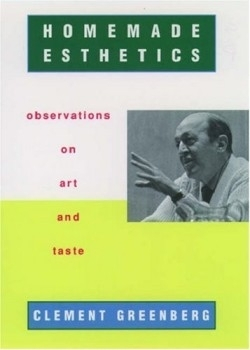Homemade Esthetics
Observations on Art and Taste
In the spirit of his 1939 essay “Avant-Garde and Kitsch” that was to prefigure his singular influence on twentieth-century art criticism, Greenberg’s Homemade Esthetics is an engrossing coda to his career (he died in 1994): implacable, intelligent, invigorating and, given the protean nature of his subject—how the intuitive experience of high art becomes that rarified thing called taste, refreshingly free of cant. Built around a series of seminars delivered at Bennington College in 1971 (along with a transcript of his audience’s questions and his responses) and nine other uncollected essays on the nature of aesthetic judgment, Greenberg, with critical aplomb, describes both the challenges of good art and the nature of bad, or mediocre art.
By granting the obvious, that art is both created and experienced in a heightened state of immediate, non-verbal sensory attention (and that art is never merely about its own content or even the idea that inspired it), he deftly undercuts criticism’s inflated rhetoric by daring to use “taste” as a criterion of judgment. And though taste is the ultimate of the personal, in the tutored eye it is transformed into being objective. Hence his sleight-of-hand: by dint of his experience and attention, his own taste has become objective; that is, good.
Following Kant’s theory that the pleasure of art consists of the free play of reason together with intuition or imagination, a state of “exalted informedness,” Greenberg looks to major art to revive us by constantly reinventing the surprise of formal expectations. No artist, he asserts, even the aggressive shock of Duchamp, Dali or Warhol, escapes the jurisdiction of taste. In exhorting his audience to test their own immediate experience of art, Greenberg insists that both viewer and artist must bear down hard on that experience. “Without pressure there is no superior art.” It is to his credit that he can share his immense appetite for art’s unique command to see. Homemade Esthetics is a spirited book of what we talk about when we talk about art.
Reviewed by
Leeta Taylor
Disclosure: This article is not an endorsement, but a review. The publisher of this book provided free copies of the book to have their book reviewed by a professional reviewer. No fee was paid by the publisher for this review. Foreword Reviews only recommends books that we love. Foreword Magazine, Inc. is disclosing this in accordance with the Federal Trade Commission’s 16 CFR, Part 255.

